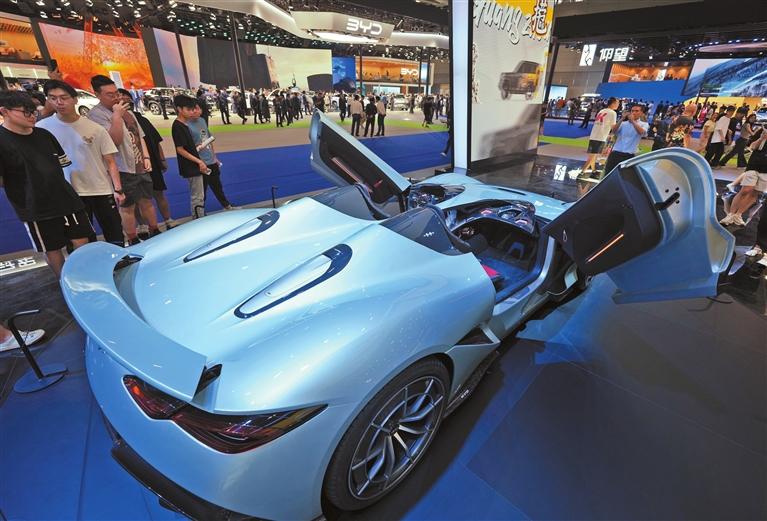
Windy Shao windysjf@hotmail.com BYD Co. made headlines with its unprecedented showcase at the Guangdong-Hong Kong-Macao Greater Bay Area International Auto Show that concluded June 9. The Shenzhen-based company seized the limelight at the event by securing an entire exhibition hall and extending its presence to the plaza outside, effectively transforming the space into a BYD-exclusive extravaganza. As the world’s largest manufacturer of new energy vehicles (NEVs), BYD sold 1.27 million units in the first five months of this year, a year-on-year increase of 26.8%. Yu Chengdong, Huawei’s executive director, also drew a large crowd of visitors when he appeared at the Harmony Intelligent Mobility Alliance (HIMA) zone June 1. The fervor and applause he received surpassed that of a pop star. The HIMA — a Huawei-initiated automotive alliance that includes members like Aito and Luxeed — reported sales of more than 134,000 vehicles from January to May 19 this year. Industry ecosystem While Shenzhen hosts industry giants like BYD and Huawei, it has also nurtured a network of important auto parts firms. At the auto show, Hall 2 of the Shenzhen World Exhibition and Convention Center in Bao’an District had a 10,000-square-meter area dedicated to highlighting key auto parts suppliers like Shenzhen-based Sunwoda Electronics and Hangsheng Electronics Co. Sunwoda is one of China’s major electric vehicle battery makers, and Hangsheng specializes in products like intelligent connected vehicle information systems, intelligent driving assistance systems, and electronic control systems. Statistics show that Shenzhen is home to 24,000 firms related to new energy, cementing its position as a heavyweight in the NEV industry. New growth engine The auto industry has gradually emerged as Shenzhen’s new economic growth engine, yielding an output value of 342.93 billion yuan (US$47.29 billion) in 2023, a year-on-year increase of 58.3%. Shenzhen produced 1.73 million NEVs last year, a year-on-year increase of 98%. Shenzhen is the world’s first megacity to electrify its entire public transportation system. Pure electric taxis were introduced as early as 2010 and the city’s taxi fleet was completely electric in 2018. Public buses were transitioned to electric power in 2017, and ride-hailing and sanitation vehicles were transitioned to electric power by 2020. The city has also set an unparalleled benchmark for NEV adoption in China by achieving the highest NEV penetration rate in the country. More than 230,000 NEVs were sold in Shenzhen in 2023, resulting in a penetration rate of 67.9%. In contrast, the national penetration rate lingered below 36% during the same period, according to the China Association of Automobile Manufacturers. Both government and corporate initiatives have supported Shenzhen’s commitment to developing its NEV infrastructure. Noteworthy among these initiatives is EV startup NIO’s ambitious agenda, which was discussed by Li Bin, chairman of NIO, at the auto show. Li said that NIO currently has more than 100 battery swap stations in Shenzhen and plans to double this number within the year. A visitor from Hong Kong at the BYD booth noted that after visiting many major mainland cities like Beijing and Shanghai, he found Shenzhen is the most convenient city for charging NEVs. Proactive initiatives Shenzhen has introduced a series of proactive measures to revolutionize its auto industry. Particularly noteworthy are campaigns designed to phase out older vehicles, promote the purchasing of new cars with incentives, and streamline the regulatory framework for sales and exchanges of used cars, according to a news conference held by the city government May 31. The city will introduce subsidies totaling 260 million yuan to encourage car owners to shift from obsolete vehicles to either NEVs or more environmentally friendly gas-powered cars. Currently, subsidies of up to 8,000 yuan for an NEV and 7,000 yuan for a new gas-powered vehicle are available. To support the transition to NEVs, investment in NEV infrastructure has been increasing. As of 2023, there had been 970,000 NEVs on Shenzhen’s roads. The city had constructed 362 supercharging stations for NEVs as of April 30, exceeding the number of gas stations, according to the city’s economic planner. Statistics from the Shenzhen Power Supply Bureau of China Southern Power Grid show that in the first quarter of the year, Shenzhen saw NEV charging reach 670 million kilowatt-hours, a 10.9% year-on-year increase. Shenzhen has set ambitious targets for the future. By 2025, the city aims to manufacture over 2 million NEVs annually. | 
